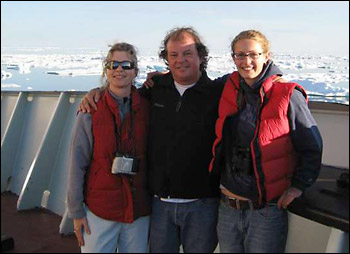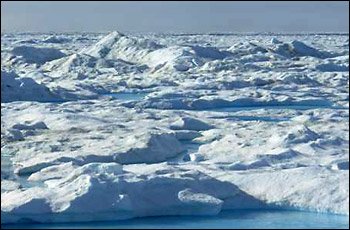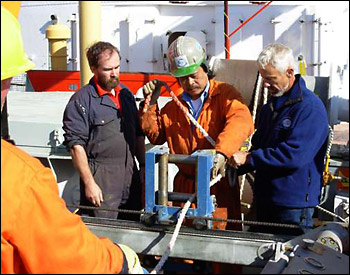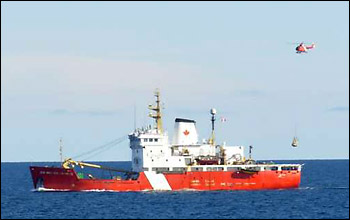Please note: You are viewing
the unstyled version of this website. Either your browser does not support CSS
(cascading style sheets) or it has been disabled. Skip
navigation.
Kris NewhallAugust 7, 2006
The plan for the next few days consists of beginning the first of many CTD (Conductivity, Temperature, Depth) casts of the cruise and recovering our first mooring, the Canadian Arctic Basin Observing System, or CABOS. Before the crew and WHOI mooring team begin any mooring operations aboard the Louis, extensive deck crew training was needed on how to use the mechanical Lebus winch system, which is used for the recovery and deployment of the ship based moorings. Will Ostrom and Kris Newhall both spent time in the cargo hold explaining and describing the specific information needed to both safely and effectively operate the winch. Once the crew understood the complexity of the winch, all went on deck to physically practice using it. Because we rely so heavily on the Lebus and the crew during the cruise, everyone had a chance to handle the controls and lines, especially boatswain Rico Amamio and Mike Dempsey (Oceanetic Measurement). As the day bore on, it was brought to our attention that the Louis and another Canadian Ice Breaker, Sir Wilfred Laurier, would be conducting an at sea transfer using the Laurier's helicopter. As it turned out, the Laurier desired much needed fresh produce to feed their officers and crew members. It was fun for everyone aboard to see the operation take place and to remind ourselves that, believe it or not, there were others operating in the Arctic. After dinner time, we were notified by the marine mammal observers, Joe Illasiak and Ian Green, that we had seen many marine mammals thus far on the trip, mostly during our transit in the gulf before getting into the pack ice. Not knowing that we had not seen more than two birds so far on the cruise, the two observers amusingly notified us that they had seen Finback, Beluga, and Bowhead whales, in addition to Seals and different Arctic fish species. It's interesting to note that Bowhead whales are the only completely native whales to the Arctic. With that in mind, it's important to pay attention at all times because even with or without a trained eye, you surely can miss many interesting sights. Last updated: October 7, 2019 | |||||||||||||||||||||
Copyright ©2007 Woods Hole Oceanographic Institution, All Rights Reserved, Privacy Policy. | |||||||||||||||||||||






